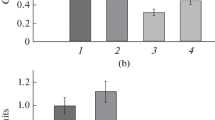Abstract
The therapeutic effects of low-power laser radiation of different wavelengths and light doses are well known, but the biochemical mechanism of the interaction of laser light with living cells is not fully understood. We have investigated the effect of MLS (Multiwave Locked System) laser near-infrared irradiation on cell membrane structure, functional properties, and free radical generation using human red blood cells and breast cancer MCF-4 cells. The cells were irradiated with low-intensity MLS near-infrared (simultaneously 808 nm, continuous emission and 905 nm, pulse emission, pulse-wave frequency, 1,000 or 2,000 Hz) laser light at light doses from 0 to 15 J (average power density 212.5 mW/cm2, spot size was 3.18 cm2) at 22 °C, the activity membrane bound acetylcholinesterase, cell stability, anti-oxidative activity, and free radical generation were the parameters used in characterizing the structural and functional changes of the cell. Near-infrared low-intensity laser radiation changed the acetylcholinesterase activity of the red blood cell membrane in a dose-dependent manner: There was a considerable increase of maximal enzymatic rate and Michaelis constant due to changes in the membrane structure. Integral parameters such as erythrocyte stability, membrane lipid peroxidation, or methemoglobin levels remained unchanged. Anti-oxidative capacity of the red blood cells increased after MLS laser irradiation. This irradiation induced a time-dependent increase in free radical generation in MCF-4 cells. Low-intensity near-infrared MLS laser radiation induces free radical generation and changes enzymatic and anti-oxidative activities of cellular components. Free radical generation may be the mechanism of the biomodulative effect of laser radiation.


Similar content being viewed by others
References
Schindl A, Schindl M, Pernerstorfer-Schon H, Schindl L (2000) Low-intensity laser therapy: a review. J Invest Med 48:312–326
Huang YY, Chen AC, Carroll JD, Hamblin MR (2009) Biphasic dose response in low level light therapy. Dose Response 7:358–383
Rochkind S, Leider-Trejo L, Nissan M, Shamir MH, Kharenko O, Alon M (2007) Efficacy of 780-nm laser phototherapy on peripheral nerve regeneration after neurotube reconstruction procedure (double-blind randomized study). Photomed Laser Surg 25:137–143
Zivin JA, Albers GW, Bornstein N, Chippendale T, Dahlof B, Devlin T, Fisher M, Hacke W, Holt W, Ilic S, Kasner S, Lew R, Nash M, Perez J, Rymer M, Schellinger P, Schneider D, Schwab S, Veltkamp R, Walker M, Streeter J (2009) Effectiveness and safety of transcranial laser therapy for acute ischemic stroke. Stroke 40:1359–1364
Wasik M, Gorska E, Modzelewska M, Nowicki K, Jakubczak B, Demkow U (2007) The influence of low-power helium-neon laser irradiation on function of selected peripheral blood cells. J Physiol Pharmacol 5(58 Suppl Pt 2):729–737
Kim YG (2002) Laser mediated production of reactive oxygen and nitrogen species; Implications for therapy. Free Radic Res 36(12):1243–1250
Chen AC-H, Arany PR, Huang Y-Y, Tomkinson EM, Sharma SK (2011) Low-level laser therapy activates NF-kB via generation of reactive oxygen species in mouse embryonic fibroblasts. PLoS One 6(7):e22453. doi:10.1371/journal.pone.0022453
Santana–Blank L, Rodriguez–Santana E, Santana–Rodriguez K (2010) Theoretic, experimental, clinical bases of the water oscillator hypothesis in near-infrared photobiomodulation. Photomed Laser Surg 28:41–52
Pagnutti S (2004) Scientific report MLS therapy. Cutting Edge Laser Technology, Italy, pp 5–23
Stocks J, Dormandy TL (1971) The autoxidation of human red cells lipids induced by hydrogen peroxide. Br J Haematol 20:95–111
Ellman GL (1958) Tissue sulfhydryl groups. Arch Biochem Biophys 82:70–77
Winterbourn CC (1990) Oxidative reactions of hemoglobin. Methods Enzymol 186:265–272
Ellman GL, Courtney KD, Andres V, Featherctone RM (1961) A new and rapid colorimetric determination of acetylcholinesterase activity. Biochem Pharm 7:88–95
LeBel CP, Ischiropoulos H, Bondy SC (1992) Evaluation of the probe 2′,7′-dichlorofluorecein as an indicator of reactive oxygen species formation and oxidative stress. Chem Res Toxicol 5:227–231
Kenston AS, Brandt R (1965) The fluorometric analysis of ultramicroquantities of hydrogen peroxide. Anal Biochem 11:1–5
Karu TI (1999) Primary and secondary mechanisms of action of visible to near- IR radiation on cells. J Photochem Photobiol B Biol 49:1–17
Gao X, Xing D (2009) Molecular mechanisms of cell proliferation induced by low power laser irradiation. J Biomed Sci 16:4
Zhang J, Xing D, Gao X (2008) Low-power laser irradiation activates Src tyrosine kinase through reactive oxygen species-mediated signaling pathway. J Cell Physiol 217(2):518–528
Lin'kova NS, Gorshkova OP, Shuvaeva VN, Dvoretskii DP (2008) Effect of low-intensity laser radiation of the red spectrum on some properties of erythrocytes in Wistar rats. Bull Exp Biol Med 145(1):7–9
Spodaryk K (2001) The influence of low-power laser energy on red blood cell metabolism and deformability. Clin Hemorheol Microcirc 25(3–4):145–151
Mi XQ, Chen JY, Liang ZJ, Zhou LW (2004) In vitro effects of helium-neon laser irradiation on human blood: blood viscosity and deformability of erythrocytes. Photomed Laser Surg 22(6):477–482
Timoshenko TE, Dvoretskiĭ DP (2010) The effect of low-intensity red and infrared laser radiation on the rat arterial and deoxygenated blood. Ross Fiziol Zh Im I M Sechenova 96(10):998–1004
Kujawa J, Zavodnik L, Zavodnik I, Bryszewska M (2003) Low-intensity near-infrared laser radiation-induced changes of acetylcholinesterase activity of human erythrocytes. J Clin Laser Med Surg 21(6):351–356
Ott P (1985) Membrane acetylcholinesterases: purification, molecular properties and interactions with amphiphilic environments. Biochim Biophys Acta 822:375–392
Wu S, Xing D, Gao X, Chen WR (2009) High fluency low-power laser irradiation induces mitochondrial permeability transition mediated by reactive oxygen species. J Cell Physiol 218(3):603–611
Acknowledgments
Work funded by the Medical University of Lodz of the research task No. 502 -03/7-127-02/502-54-027.
Conflict of interest
No competing financial interests exist.
Author information
Authors and Affiliations
Corresponding author
Rights and permissions
About this article
Cite this article
Kujawa, J., Pasternak, K., Zavodnik, I. et al. The effect of near-infrared MLS laser radiation on cell membrane structure and radical generation. Lasers Med Sci 29, 1663–1668 (2014). https://doi.org/10.1007/s10103-014-1571-y
Received:
Accepted:
Published:
Issue Date:
DOI: https://doi.org/10.1007/s10103-014-1571-y




